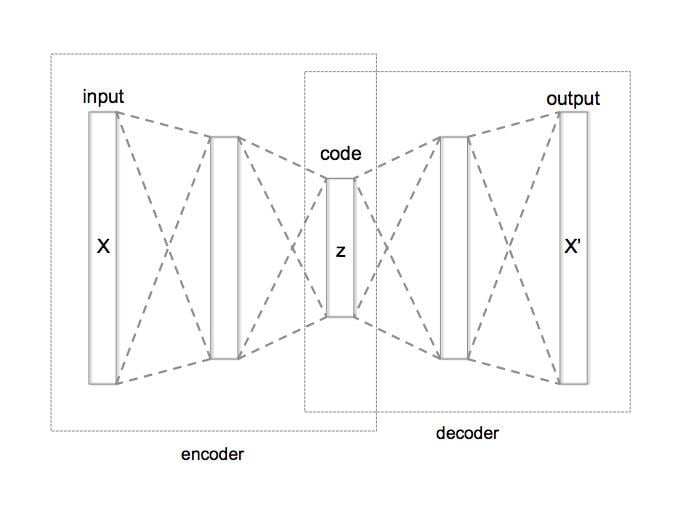 | ||
An autoencoder, autoassociator or Diabolo network is an artificial neural network used for unsupervised learning of efficient codings. The aim of an autoencoder is to learn a representation (encoding) for a set of data, typically for the purpose of dimensionality reduction. Recently, the autoencoder concept has become more widely used for learning generative models of data.
Contents
Structure
Architecturally, the simplest form of an autoencoder is a feedforward, non-recurrent neural network very similar to the multilayer perceptron (MLP) – having an input layer, an output layer and one or more hidden layers connecting them –, but with the output layer having the same number of nodes as the input layer, and with the purpose of reconstructing its own inputs (instead of predicting the target value
An autoencoder always consists of two parts, the encoder and the decoder, which can be defined as transitions
In the simplest case, where there is one hidden layer, an autoencoder takes the input
This is usually referred to as code or latent variables (latent representation). Here,
Autoencoders are also trained to minimise reconstruction errors (such as squared errors):
If the feature space
Variations
Various techniques exist to prevent autoencoders from learning the identity function and to improve their ability to capture important information and learn richer representations:
Denoising autoencoder
Denoising autoencoders take a partially corrupted input whilst training to recover the original undistorted input. This technique has been introduced with a specific approach to good representation. A good representation is one that can be obtained robustly from a corrupted input and that will be useful for recovering the corresponding clean input. This definition contains the following implicit assumptions:
To train an autoencoder to denoise data, it is necessary to perform preliminary stochastic mapping
Sparse autoencoder
By imposing sparsity on the hidden units during training (whilst having a larger number of hidden units than inputs), an autoencoder can learn useful structures in the input data. This allows sparse representations of inputs. These are useful in pretraining for classification tasks.
Sparsity may be achieved by additional terms in the loss function during training (by comparing the probability distribution of the hidden unit activations with some low desired value), or by manually zeroing all but the few strongest hidden unit activations (referred to as a k-sparse autoencoder).
Variational autoencoder (VAE)
Variational autoencoder models inherit autoencoder architecture, but make strong assumptions concerning the distribution of latent variables. They use variational approach for latent representation learning, which results in an additional loss component and specific training algorithm called Stochastic Gradient Variational Bayes (SGVB). It assumes that the data is generated by a directed graphical model
Here,
Contractive autoencoder (CAE)
Contractive autoencoder adds an explicit regularizer in their objective function that forces the model to learn a function that is robust to slight variations of input values. This regularizer corresponds to the Frobenius norm of the Jacobian matrix of the encoder activations with respect to the input. The final objective function has the following form:
Relationship with truncated singular value decomposition (TSVD)
If linear activations are used, or only a single sigmoid hidden layer, then the optimal solution to an autoencoder is strongly related to principal component analysis (PCA), as explained by Pierre Baldi in several papers.
Training
The training algorithm for an autoencoder can be summarized as
For each input x, Do a feed-forward pass to compute activations at all hidden layers, then at the output layer to obtain an outputAn autoencoder is often trained using one of the many variants of backpropagation (such as conjugate gradient method, steepest descent, etc.). Though these are often reasonably effective, there are fundamental problems with the use of backpropagation to train networks with many hidden layers. Once errors are backpropagated to the first few layers, they become minuscule and insignificant. This means that the network will almost always learn to reconstruct the average of all the training data. Though more advanced backpropagation methods (such as the conjugate gradient method) can solve this problem to a certain extent, they still result in a very slow learning process and poor solutions. This problem can be remedied by using initial weights that approximate the final solution. The process of finding these initial weights is often referred to as pretraining.
Geoffrey Hinton developed a pretraining technique for training many-layered "deep" autoencoders. This method involves treating each neighbouring set of two layers as a restricted Boltzmann machine so that the pretraining approximates a good solution, then using a backpropagation technique to fine-tune the results. This model takes the name of deep belief network.
